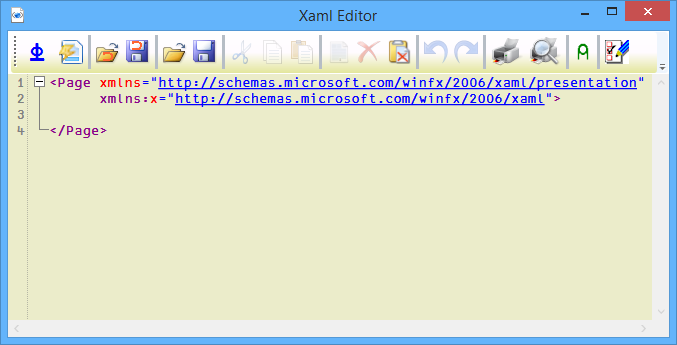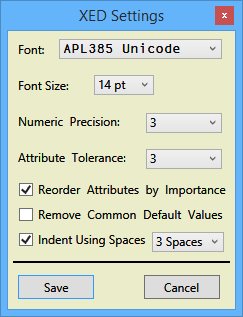wpfXamlEditor
UNDER CONSTRUCTION
Overview
wpfXamlEditor is a Xaml editor for an APL variable in a workspace or for a file on disk. The user command is able to show the Xaml in color with folding, print it, reorganize it so it is more readable according to some settings set by the user. It is inspired by the work of Robby Ingebretsen of Kaxaml (http://www.Kaxaml.com). It is particularly valuable to the users that like to keep their Xaml in the workspace. With XamlEditor they have a tool to maintain it without effort.
Usage
Once installed the user command can be invoke by typing ]XamlEditor (casing is not important, no argument). The following start-up screen should appear:

Here is a short description for each buttons:
Button |
Explanation |
Button |
Explanation |
|
Execute the Xaml and Show the Result in a Separate Window |
|
Select All the Xaml |
|
Scrub the Xaml According to Settings |
|
Delete the Selected Text |
|
Open a Dialog Box to Select a Xaml Variable in the WS |
|
Clear the Clipboard |
|
Open a Dialog Box to Save the Xaml as a Variable in the WS |
|
Undo Last Operation |
|
Open a Dialog Box to Select a File on Disk |
|
Redo Previous Operation |
|
Open a Dialog Box to Save the Xaml to a File |
|
Print All the Xaml |
|
Cut the Selected Text to The Clipboard |
|
Print Preview All the Xaml |
|
Copy the Selected Text to the Clipboard |
|
Make Selected Text a Comment |
|
Paste the Text From the clipboard |
|
Choose the Settings when Scrubbing |
The settings for scrubbing are saved in a xml file named XED.Settings.xml. The file will be created automatically the first time the user command runs. It will be located next to the wpfXamlEditor.dyalog file or in the AppData directory depending on the Windows version and security. The data of the file looks like this:
<Settings> <EditorFont>APL385 Unicode</EditorFont> <EditorFontSize>14</EditorFontSize> <ReducePrecision>0</ReducePrecision> <Precision>10</Precision> <AttributeCounteTolerance>2</AttributeCounteTolerance> <ReorderAttributes>1</ReorderAttributes> <RemoveCommonDefaultValues>1</RemoveCommonDefaultValues> <ConvertTabsToSpaces>1</ConvertTabsToSpaces> <SpaceCount>2</SpaceCount> </Settings>
It is used to build the Settings window (button ![]() of the command bar).
of the command bar).

Look at the individual tooltips on the Window for more information on each settings.
Installation
Download the following file wpfXamlEditor.1.0.zip. UnZip and copy the files to your user command directory (for advice how to organize your User Commands see UserCommands/WhereShouldTheyGo). The downloaded file contains the Dyalog user command file wpfXamlEditor.dyalog and a dll named ICSharpCode.AvalonEdit.dll. That dll is free of charge and can be downloaded from CodeProject or from AvalonEdit but is included in the zip file for commodity.
If the first time you run the user command you get an error similar to this: EXCEPTION: Request for the permission of type System.Security.Permissions.SecurityPermission, mscorlib, Version=4.0.0.0, Culture=neutral, PublicKeyToken=b77a5c561 934e089' failed. it is because the dll cannot run. Depending on the version of Windows and the security you will need to either right click on the dll and if you see and UnBlock button, click on it and try again. If the UnBlock button is not present you will need to modify the manifest file named dyalog.exe.config that is located in the same directory as dyalog.exe. The manifest file should look like this (if not present you will need to create it and add it to the directory while in administrator mode):
<configuration>
<startup useLegacyV2RuntimeActivationPolicy="true">
<supportedRuntime version="v4.0"/>
</startup>
<runtime>
<!-- <NetFx40_LegacySecurityPolicy enabled="true"/> -->
<loadFromRemoteSources enabled="true"/>
<trust level="Full"/>
</runtime>
</configuration> APL Wiki
APL Wiki